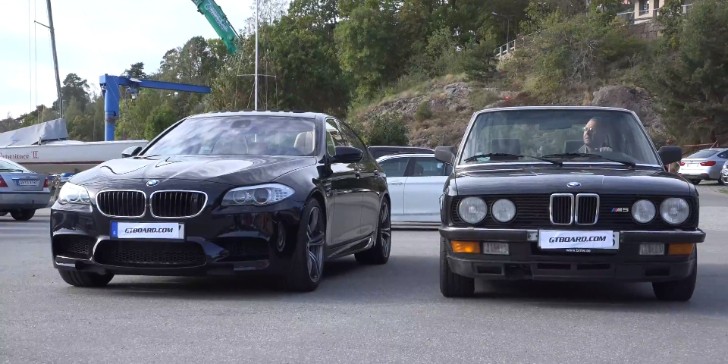BMW celebrated the 30th anniversary of their emblematic M5 model this year with a special model. Dubbed 30 Jahre Edition, the limited-production car became the most powerful and the fastest model they ever made. Now, we’re taking a closer look at how the M5 evolved over 3 decades.
The guys from GTBoard.com had the opportunity to film a BMW E28 M5 in mint condition right next to a current day F10 M5. What better way to compare the two than by shooting them side by side?
Back in the 1980s BMW introduced the E28 M5, a car that would go on an write history not only during that period but also later on through its descendants. Making its debut at the Amsterdam Motor Show in 1985, the car was featuring (in its European spec version) the same engine as the E24 M635CSi model, an evolution of the M88 plant used on the legendary M1.
That engine was later known as S38 in the United States, Japan and Canada, where it was sold with different catalytic converters (amongst others) to be ‘cleaner’. They are also rated at 256 HP instead of 286 HP as the European model was and had marginally less torque at 243 lb-ft (329 Nm) compared to 251 lb-ft (340 Nm).
However, back then, it was using the trademark inline 6-cylinder architecture imbued in a 3.5-liter total displacement. The engines as well as the car were hand-built back then, limiting the number of cars produced to a total of 2,241 units.
Sure, it might seem like it doesn’t hold a candle to the E28 but all that extra weight is actually justified when you simply look at the thing. It has everything you could possibly want on a car, from electrically adjustable seats, to plenty of airbags to save your life in case of an accident.
The performance is rather different too, the current car being roughly 2 seconds faster to 62 mph (100 km/h) than the original model and being capable of reaching 186 mph (300 km/h) when de-restricted.
Back in the 1980s BMW introduced the E28 M5, a car that would go on an write history not only during that period but also later on through its descendants. Making its debut at the Amsterdam Motor Show in 1985, the car was featuring (in its European spec version) the same engine as the E24 M635CSi model, an evolution of the M88 plant used on the legendary M1.
That engine was later known as S38 in the United States, Japan and Canada, where it was sold with different catalytic converters (amongst others) to be ‘cleaner’. They are also rated at 256 HP instead of 286 HP as the European model was and had marginally less torque at 243 lb-ft (329 Nm) compared to 251 lb-ft (340 Nm).
However, back then, it was using the trademark inline 6-cylinder architecture imbued in a 3.5-liter total displacement. The engines as well as the car were hand-built back then, limiting the number of cars produced to a total of 2,241 units.
30 Years Later, things changed drastically
Now, the current M5 is no longer the nimble, lightweight, hand-built car the Germans used to make. Today, the car weighs nearly 2 tons and has a 4.4-liter V8 under the bonnet that’s also turbocharged, something nobody expected 30 years ago.Sure, it might seem like it doesn’t hold a candle to the E28 but all that extra weight is actually justified when you simply look at the thing. It has everything you could possibly want on a car, from electrically adjustable seats, to plenty of airbags to save your life in case of an accident.
The performance is rather different too, the current car being roughly 2 seconds faster to 62 mph (100 km/h) than the original model and being capable of reaching 186 mph (300 km/h) when de-restricted.

